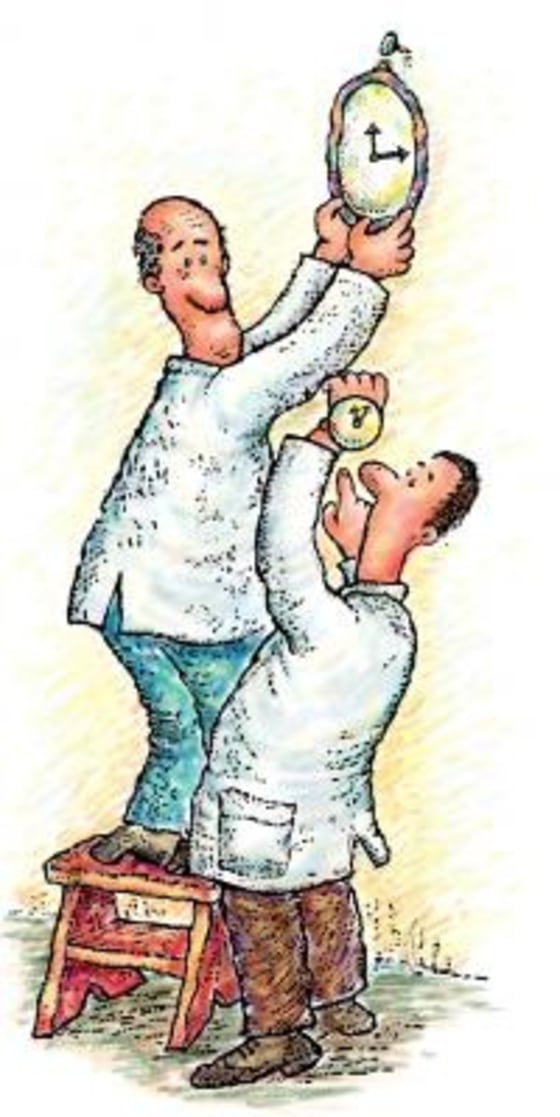Repeated tests have shown that the theory of relativity affects satellites orbiting Earth as well as galaxy clusters billions of light-years away ... but does it affect you when you're going up the stairs? Experiments reported in this week's issue of the journal Science say yes. According to general relativity, someone who lives on the second floor of an apartment building should age ever so slightly faster than the neighbor downstairs — because Earth's gravitational force is ever so slightly weaker. Wristwatches should run faster as well. The experiments conducted by physicists at the National Institute of Standards and Technology in Boulder, Colo., show that it really, really works that way. But don't move to the basement just to extend your life: Over the course of 80 years, that slight difference would add up to far less than a millionth of a second. The NIST researchers found that a height difference of about one foot (33 centimeters) resulted in a time variance of roughly a billionth of a second per year. That time difference is too small for humans or even most clocks to measure directly — however, even trillionths of a second could make a difference in future scientific applications. After all, readings from the Global Positioning System's satellites have to be adjusted to compensate for relativity's effects. Twice. Because of general relativity, the satellites' nanosecond-accurate clocks would speed up relative to the ground by 45 microseconds per day. But because of special relativity, which applies to objects moving in different frames of reference, there would be a slowdown effect for the clocks in motion aboard the satellites, to the effect of 7 microseconds per day. The bottom line, as explained by Ohio State University astronomer Richard Pogge on this Web page, is that there would be a net speedup of 38 microseconds a day. Because the GPS satellites determine location by making highly precise measurements of radio transmission times, they'd quickly become totally useless if they couldn't compensate for the speedup. That's why the atomic clocks and the onboard computers have been tweaked to take relativity into account. You can learn more about relativity and its applications to the real world by clicking through our interactive graphic, "Putting Einstein to the Test," which also explains Albert Einstein's famous "twin paradox." That's the story about one brother who gets on a rocket ship and travels through space for decades at a velocity close to the speed of light. When he returns to Earth, he has aged markedly less than his doddering twin brother. The time difference is due to special relativity — that is, the fact that the jetsetting brother was in relativistic motion as seen from Earth's reference frame. This old-school calculator from PBS' "Nova" program lets you turn the dials and see how relativity would affect the twins' ages (Shockwave plug-in required). The NIST researchers used their aluminum-ion clocks to check on the truth of the twin paradox as well. Here's how they did it: Usually, the ions in the atomic clocks are motionless during measurements. But the researchers fiddled with the ion in one clock so that it gyrated back and forth at speeds equivalent to going several meters (yards) per second. The clock with the moving ion ticked more slowly than the clock with the stationary ion, just like the heart of the traveling twin. It's nice to know that Einstein was right again, but the clock research could have practical as well as theoretical applications: NIST is planning to improve the precision of its aluminum-ion clocks so that they can detect how time flows differently on the scale of a centimeter (half an inch) in height difference. That could open the way for the use of atomic-clock networks as "inland tidal gauges." NIST says such networks could record the ups and downs in Earth's gravity field created by geological shifts. And that information, in turn, could provide a better understanding of how seismic events arise. "If you have plate movement that's a redistribution of mass contributing to Earth's gravity field, we should be able to see that with a network of clocks connected by optical fibers," NIST's James Chin-Wen Chou, the principal author of the Science paper, told me today. Beyond relativity, more precise clocks could lead to more accurate GPS systems — for example, systems that could tell a robot-driven automobile not to veer so close to the highway lane divider. "With higher accuracy, we might be able to get higher resolution in our receiver," Chou said. More about relativity and clocks:
- Einstein's revolution enters second century
- Black hole puts a dent in space-time continuum
- Stephen Hawking says time travel may be possible
- Clarifying Einstein's rules of the road for relativity
- Satellite maps our planet's gravity field
- Ultra-precise atomic clocks will redefine time
- NIST: Aluminum-ion device is world's most precise clock
- Inside Science: Time moves faster upstairs
The authors of the Science paper, "Optical Clocks and Relativity," include Chou as well as D.B. Hume, T. Rosenband and D.J. Wineland of NIST's Time and Frequency Division. The research was supported in part by the Office of Naval Research. This report was last updated at 6:30 p.m. ET, give or take a few nanoseconds.Check out my other postings on Cosmic Log, and connect with me via Twitter (@b0yle) or Facebook.
